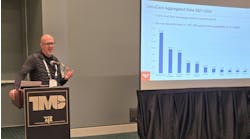FMCSA closer to final HD AEB rule, speed limiter proposal in progress
The White House Office of Management and Budget released the Spring Regulatory Agenda in July, sharing a list of the rules and regulations that federal agencies have on their plates.
For trucking, the major rules to watch are automatic emergency braking and speed limiters. Next year, the Federal Motor Carrier Association may issue a final rule requiring standardized AEB systems in new vehicles and a notice of proposed rulemaking to require speed-limiting devices.
Before any major rules hit the books, however, the trucking industry will likely have to wait until after this year’s elections.
“We’re going to see—and, truly, we have seen already—a slowdown in rulemakings coming from the agencies,” Dan Horvath, American Trucking Associations’ SVP of regulatory affairs and safety policy, told Fleet Maintenance's sister publication FleetOwner. “That will likely stay in place going into the election season.”
See also: What elimination of Chevron deference means for trucking
While the regulatory agenda gives tentative schedules for each rulemaking, Horvath also cautions the industry to take these dates with a grain of salt.
“We’ve seen regulatory items on this list that have stayed on there for years and years. We’ve seen items come off with no actual rulemaking come into place, and then we’ve seen items added back. To us, we use this as a guide to understand what the DOT is working on ... so we can have a better expectation for process.”
Automatic emergency braking awaits final rule
The National Highway Traffic Safety Administration and the Federal Motor Carrier Administration plan to issue the Final Rule to standardize equipment performance for AEB systems on heavy trucks.
The rule would establish standards for new Class 3 and larger vehicles as well as accompanying test procedures.
The agencies published the notice of proposed rulemaking in June 2023 and expect to publish the final rule in early 2025.
“We were expecting that to come out that summer; that looks like it has been delayed as well,” Horvath said. “We get the sense that the agency is close to being done with that final rule. They just need a little bit of time.”
Speed limiter SNPRM in the works
FMCSA plans to issue a second notice of proposed rulemaking for speed-limiting devices.
The first notice of proposed rulemaking for speed limiters was published eight years ago, in September 2016. In that document, FMCSA and NHTSA proposed regulations requiring speed-limiting devices on new vehicles with a GVWR of more than 26,000 lbs. The specific speed limit, however, was left to be specified in the final rule.
In 2022, FMCSA announced that it intends to proceed with a speed limiter rulemaking by preparing the supplemental notice of proposed rulemaking.
“We still don’t know what FMCSA is proposing with regard to what the maximum speed will be,” Horvath said. “We’re at a wait-and-see perspective at this point.”
The agency plans to publish the SNPRM around May 2025.
“Normally, in the updated regulatory agenda, we would see dates pushed back maybe just a few months. This is a case where FMCSA has pushed it back nearly a year to May of 2025,” Horvath pointed out. “They’ve taken the stance that this is an important rulemaking. Whether you agree with speed limiters or you disagree with speed limiters, there’s a lot that goes into this.”
As a proposed rule, affected parties would still have the opportunity to submit their comments on the rulemaking before the final rule.
Election season slows down rulemaking
The months before and after major elections slow down rulemaking. After the change in administration in 2025, regardless of the candidates, agencies will likely pause their rulemaking as the new president sorts their personnel.
With a change in administration, Horvath said, “We typically see what’s called a regulatory freeze. That’s especially relevant when we go from a Democratic administration to a Republican administration or vice versa.
“With any rulemaking that has not been finalized prior to the new administration, what the new administration will do is hold everything while they have a chance to review it, while they have a chance to assemble their teams ... and take the time to review any regulations that are coming out.”
Once the new president has the time to review regulations and assemble their staff, rulemaking will likely assume a more regular pace. What rules will move on, however, depends on the new president’s priorities and agency leadership.
This article was originally published on FleetOwner.com.



